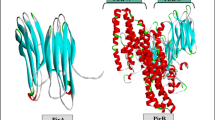Abstract
In shrimp aquaculture, a major economic loss due to the bacterial disease called acute hepatopancreatic necrosis disease (AHPND) infected by Vibrio parahaemolyticus and caused the highest mortality (100%). Many approaches have been addressed to control vibriosis diseases in the shrimp industry, such as water monitoring and replacements, management practices and use of antibiotics but not fully controlled. V. parahaemolyticus has important virulence factors such as thermostable direct hemolysin (TDH) and TDH-related hemolysin (TRH), both are strongly directly associated with pathogenicity. Materials can be designed to specifically target PirA, PirB, TDH, and TRH, offering a targeted and effective approach to prevent infections in aquaculture. In the present study, in silico approach to unveil the potential of nanomaterials (ZnO, CuO, Se, and Fe2O3) as inhibitors against the toxins and thermostable proteins of V. parahaemolyticus has been studied via molecular docking analysis, AutoDock paired an empirical free energy force field with a Lamarckian Genetic Algorithm was used. The interaction results were visualized using molecular graphics tool Chimera. The current work is focused on predicting the ligands (ZnO, CuO, Se, and Fe2O3 nanoparticles) interact with the toxin and thermostable proteins of V. parahaemolyticus. The conformations of ligands bonded to macromolecular proteins can be assessed with the use of computational docking. These findings may be used to develop novel strategies for halting as well as controlling V. parahaemolyticus infections.





Similar content being viewed by others
References
Ahmed, J., Khan, M. H., Unnikrishnan, S., & Ramalingam, K. (2022). Acute hepatopancreases necrosis diseases (AHPND) as challenging threat in shrimp. Biointerf Res Appl Chem., 12(1), 978–991.
Nations, F. A. A. O. O. T. U. (2018). FAO yearbook – Fishery and aquaculture statistics 2016. Food & Agriculture Org. http://books.google.ie/books?id=zNZmDwAAQBAJ&printsec=frontcover&dq=FAO+yearbook+(2017)+Fishery+and+aquaculture+statistics&hl=&cd=2&source=gbs_api
Zheng, Z., Li, R., Aweya, J. J., Yao, D., Wang, F., Li, S., Tuan, T. N., & Zhang, Y. (2021). The PirB toxin protein from Vibrio parahaemolyticus induces apoptosis in hemocytes of Penaeus vannamei. Virulence, 12(1), 481–492.
Shinn, A. P., Pratoomyot, J., Griffiths, D., Trong, T. Q., Vu, N. T., & Jiravanichpaisal, P. (2018). Briggs M (2018) Asian shrimp production and economic costs of disease. Asian Fisheries Science, 31S, 29–58.
Tran, L., Nunan, L., Redman, R. M., Mohney, L. L., Pantoja, C. R., Fitzsimmons, K., & Lightner, D. V. (2013). Determination of the infectious nature of the agent of acute hepatopancreatic necrosis syndrome affecting penaeid shrimp. Dis Aquat Organ., 105(1), 45–55.
Han, J. E., Mohney, L. L., Tang, K. F. J., Pantoja, C. R., & Lightner, D. V. (2015). Plasmid mediated tetracycline resistance of Vibrio parahaemolyticus associated with acute hepatopancreatic necrosis disease (AHPND) in shrimps. Aquacult Rep, 2, 17–21.
Gu, X., Liu, M., Wang, B., Jiang, K., & Wang, L. (2022). Identification and expression analysis of an interacting protein (LvFABP) that mediates Vibrio parahaemolyticus AHPND toxin action. Frontiers in Immunology, 13, 940405.
Kumar, V., Bels, L. D., Couck, L., Baruah, K., Bossier, P., & Broeck, W. V. D. (2019). PirABVP toxin binds to epithelial cells of the digestive tract and produce pathognomonic AHPND lesions in germ-free brine shrimp. Toxins, 11(12), 717.
Lee, C. T., Chen, I. T., Yang, Y. T., Ko, T. P., Huang, Y. T., Huang, J. Y., Huang, M. F., Lin, S. J., Chen, C. Y., Lin, S. S., Lightner, D. V., Wang, H. C., Wang, A. H. J., Wang, H. C., Hor, L. I., & Lo, C. F. (2015). The opportunistic marine pathogen Vibrio parahaemolyticus becomes virulent by acquiring a plasmid that expresses a deadly toxin. Proceedings National Academy Sci United States Am, 112, 10798–10803.
Wang, H., Wang, C., Tang, Y., Sun, B., Huang, J., & Song, X. (2018). Pseudoalteromonas probiotics as potential biocontrol agents improve the survival of Penaeus vannamei challenged with acute hepatopancreatic necrosis disease (AHPND)-causing Vibrio parahaemolyticus. Aquaculture, 494, 30–36.
Burridge, L., Weis, J. S., Cabello, F., Pizarro, J., & Bostick, K. (2010). Chemical use in Salmon aquaculture: A review of current practices and possible environmental effects. Aquaculture, 306(1–4), 7–23.
Zhai, Q. Q., & Li, J. (2019). Effectiveness of traditional Chinese herbal medicine, San-Huang-San, in combination with enrofloxacin to treat AHPND-causing strain of Vibrio parahaemolyticus infection in Litopenaeus vannamei. Fish & Shellfish Immunology, 87, 360–370.
Chang, Y. H., Kuo, W. C., Wang, H. C., & Chen, Y. M. (2020). Biocontrol of acute hepatopancreatic necrosis disease (AHPND) in shrimp using a microalgal-bacterial consortium. Aquaculture, 512, 734990.
Crab, R., Defoirdt, T., Bossier, P., & Verstraete, W. (2012). Biofloc technology in aquaculture: Beneficial effects and future challenges. Aquaculture, 356, 351–356.
Vaughan, E. E., de Vries, M., Zoetendal, E. G., Ben-Amor, K., Akkermans, A. D., & Vos, W. D. (2002). The intestinal labs. Antonie van Leeuwenhoek, 82(1–4), 341.
Ding, X., Li, Z. J., Chen, Y. Q., Lin, H. Z., & Yang, K. (2004). Effects of probiotics on growth and activities of digestive enzymes of Pennaus vannamei. J Fishery Sci China, 11, 580–584.
Shan, H., & Obbard, J. (2001). Ammonia removal from prawn aquaculture water using immobilized nitrifying bacteria. Applied Microbiology and Biotechnology, 57(5–6), 791–798.
Morris, G. M., Huey, R., Lindstrom, W., Sanner, M. F., Belew, R. K., Goodsell, D. S., & Olson, A. J. (2009). Autodock4 and AutoDockTools4: Automated docking with selective receptor flexibility. J. Computational Chem., 16, 2785–2791.
O’Boyle, N. M., Banck, M., James, C. A., Morley, C., Vandermeersch, T., & Hutchison, G. R. (2011). Open Babel: An open chemical toolbox. J Cheminformatics, 3(1), 33.
Tian, W., Chen, C., Lei, X., Zhao, J., & Liang, J. (2018). CASTp 3.0: Computed atlas of surface topography of proteins. Nucleic Acids Research, 46(W1), W363–W367. https://doi.org/10.1093/nar/gky473
Rahman, A., Ali, M. T., Shawan, M. M. A. K., Sarwar, M. G., Khan, M. A. K., & Halim, M. A. (2016). Halogen-directed drug design for Alzheimer’s disease: A combined density functional and molecular docking study. Springerplus, 5, 1346.
Pettersen, E. F., Goddard, T. D., Huang, C. C., Couch, G. S., Greenblatt, D. M., Meng, E. C., & Ferrin, T. E. (2004). UCSF Chimera - A visualization system for exploratory research and analysis. J Computational Chem., 25(13), 1605–1612.
Laskowski, R. A., & Swindells, M. B. (2011). LigPlot+: Multiple ligand-protein interaction diagrams for drug discovery. Journal of Chemical Information and Modeling, 51, 2778–2786.
Shawan, M. M. A. K., Sharma, A. R., Bhattacharya, M., Mallik, B., Akhter, F., Shakil, Md. S., Hossain, Md. M., Banik, S., Lee, S. S., Hasan, Md. A., & Chakraborty, C. (2021). Designing an effective therapeutic siRNA to silence RdRp gene of SARS-CoV-2. Infection, Genet Evol, 93, 104951.
Shawan, M. M. A. K., Halder, S. K., & Hasan, M. A. (2021). Luteolin and abyssinone II as potential inhibitors of SARS-CoV-2: An in silico molecular modeling approach in battling the COVID-19 outbreak. Bull Natl Res Cent, 45, 27.
Halder, S. K., Sultana, I., Shuvo, M. N., Shil, A., Himel, M. K., Hasan, M. A., & Shawan, M. M. A. K. (2023). In silico identification and analysis of potentially bioactive antiviral phytochemicals against SARS-CoV-2: A molecular docking and dynamics simulation approach. BioMed Research International, 2023, 1–32. https://doi.org/10.1155/2023/5469258
Shawan, M. M. A. K., Sharma, A. R., Halder, S. K., Arian, T. A., Shuvo, Md. N., Sarker, S. R., & Hasan, Md. A. (2023). Advances in computational and bioinformatics tools and databases for designing and developing a multi-epitope-based peptide vaccine. Int J Peptide Res Therapeutics, 29, 60.
Mahalakshmi, N., & Rajavel, R. (2014). Synthesis, spectroscopic, DNA cleavage and antibacterial activity of binuclear Schiff base complexes. Arabian J Chem, 7, 509–517.
Zheng, K., Yan, M. X., Li, Y. T., Wu, Z. Y., & Yan, C. W. (2016). Synthesis and structure of new dicopper(II) complexes bridged by N-(2-hydroxy-5-methylphenyl)-N′-[3-(dimethylamino)propyl] oxamide with in vitro anticancer activity: A comparative study of reactivities towards DNA/protein by molecular docking and experimental assays. European J Med Chem., 109, 47–58.
Vinu, D., Govindaraju, K., Vasantharaja, R., Amreen Nisa, S., Kannan, M., & Vijai Anand, K. (2021). Biogenic zinc oxide, copper oxide and selenium nanoparticles: Preparation, characterization and their anti-bacterial activity against Vibrio parahaemolyticus. J Nanostruct Chem, 11, 271–286.
Hamdi, M., Abdel-Bar, H. M., Elmowafy, E., El-khouly, A., Mansour, M., & Awad, G. A. (2021). Investigating the internalization and COVID-19 antiviral computational analysis of optimized nanoscale zinc oxide. ACS Omega, 6(10), 6848–6860. https://doi.org/10.1021/acsomega.0c06046
Pandey, M., Singh, M., Wasnik, K., Gupta, S., Patra, S., Gupta, P. S., Pareek, D., Chaitanya, N. S. N., Maity, S., Reddy, A. B. M., Tilak, R., & Paik, P. (2021). Targeted and enhanced antimicrobial inhibition of mesoporous ZnO–Ag2O/Ag, ZnO–CuO, and ZnO–SnO2 composite nanoparticles. ACS Omega, 6(47), 31615–31631. https://doi.org/10.1021/acsomega.1c04139
Ikram, M., Shahzadi, A., Haider, A., Imran, M., Hayat, S., Haider, J., Ul-Hamid, A., Rasool, F., Nabgan, W., Mustajab, M., Ali, S., & Al-Shanini, A. (2023). Toward efficient bactericidal and dye degradation performance of strontium and starch-doped Fe2O3 nanostructures: In silico molecular docking studies. ACS Omega, 8(8), 8066–8077.
Yoon, J., Bae, Y., & Lee, S. (2017). Effects of varying concentrations of sodium chloride and acidic conditions on the behavior of Vibrio parahaemolyticus and Vibrio vulnificus cold-starved in artificial sea water microcosms. Food Sci Biotechnol, 26(3), 829–839.
Funding
Ministry of Earth Sciences, Earth Science and Technology Cell (MoES/11-MRDFIESTC-MEB (SU)/2/2014 PCIII) & National Innovations on Climate Resilient Agriculture (NICRA), Indian Council of Agricultural Research (ICAR-F.No.2–13(8)/19–20 NICRA), Government of India for their financial support.
Author information
Authors and Affiliations
Contributions
Vinu D conceived, performed the experiments. Santhiya P performed the experiments, coordinated the study, and drafted the manuscript. Govindaraju K edited the manuscript and supervision.
Corresponding author
Ethics declarations
Competing interests
The authors declare no competing interests.
Informed Consent
None
Research Involving Humans and Animals Statement
None
Conflict of Interest
All authors declare that there are no competing interests.
Additional information
Publisher's Note
Springer Nature remains neutral with regard to jurisdictional claims in published maps and institutional affiliations.
Rights and permissions
Springer Nature or its licensor (e.g. a society or other partner) holds exclusive rights to this article under a publishing agreement with the author(s) or other rightsholder(s); author self-archiving of the accepted manuscript version of this article is solely governed by the terms of such publishing agreement and applicable law.
About this article
Cite this article
Dayalan, V., Panchalingam, S. & Kasivelu, G. In silico Approach to Unveil Robust Anti-Vibrio parahaemolyticus Activity of Nano Complex. BioNanoSci. (2024). https://doi.org/10.1007/s12668-024-01325-z
Accepted:
Published:
DOI: https://doi.org/10.1007/s12668-024-01325-z




